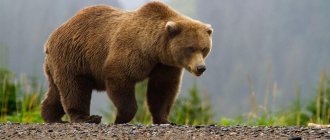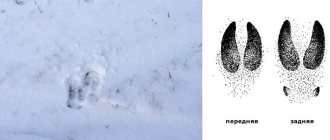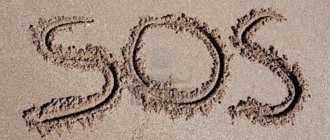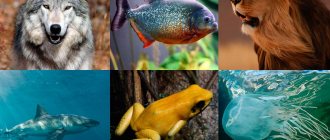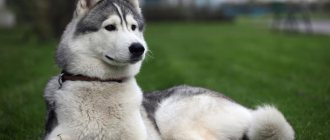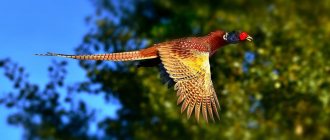If you enter a summer forest during the day, it will seem that only birds and insects live in it. In winter, it may appear completely uninhabited. However, is there something? What betrays the animal presence are their paw prints. The tracks of a bear and elk, a fox and a wolf, a hare and a mouse clearly tell the observer that these creatures inhabit the forest area.
What is trace freshness and how is it determined?
It is interesting for the observer, and important for the hunter, to know when this or that trace was left. The animal passed here a few days ago, or maybe hours? Or is it still running somewhere ahead? This is indicated by such a concept as the freshness of the trace.
If it snowed late in the evening or at night, then a bear’s paw print found in the morning will indicate that it is nocturnal and no more than a few hours old. You should be careful, because in winter only the connecting rod bear can leave its prints.
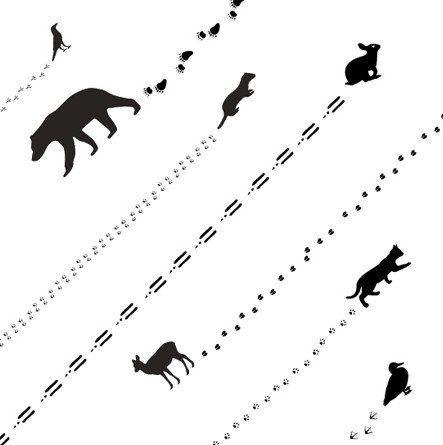
Experts suggest determining the freshness of a trace by touch. If it is frosty outside and the snow is dry, then at first its boundaries will not differ in looseness from the rest of the surface. Over time, the walls of the footprint harden. This process directly depends on the air temperature. The stronger the frost, the faster the edges of the print become hard. But this only applies to large animals, for example, if these are traces of a brown bear or a wolf. Because small animals leave imprints on the surface. And there the hardening is not noticeable.
Polar bear
This representative of the bear is significantly different from the brown one, both in appearance and in eating habits. The polar bear is exclusively carnivorous. Prefers cold habitat. Spends part of the time in water. The weight of the animal is from 800 kg to 1 ton, and reaches 3 meters in length. The distinctive feature of the polar bear is its flat muzzle and long neck. The fur coat changes color depending on the weather. With frequent exposure to the sun, the coat fades from white to yellow. Another important fact suggests that this species does not go into long-term hibernation; most often, pregnant females sleep for 80 days.
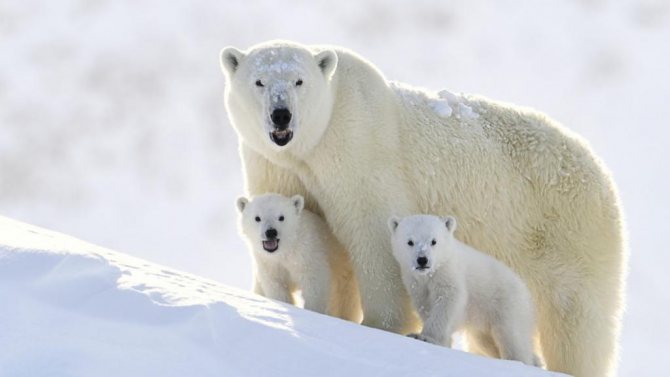
The bear footprint looks like a human foot shod in fur shoes. This comparison is appropriate due to the fact that the sole of the paw is covered with thick hair. Thanks to this feature, the bear does not slip and moves freely on ice and snow. Polar bears have a swimming membrane between their toes. The length of the paw print, not counting the claws, is 15-18 cm long and 16-19 cm wide.
How to determine the direction of movement of an animal?
To do this, you need to carefully examine the tracks in the snow. Animals that are quite large in size can be easily identified by the size of their print. The observer may notice that its walls are different.
On the side where the trail has the back wall, a flatter edge will be visible. This is explained by the fact that the animal places its limbs hollow and takes them out of the snow almost vertically. These boundaries even have their own names: dragging and dragging, respectively. The drag is always shorter than the drag. That is, the front wall is steeper than the back. Therefore, the animal moved in the direction the dragging was directed.
How to recognize the gait of an animal by its footprint?
In other words, the gait of movement. It comes in two types. The first characterizes a slow and moderately fast pace of movement. It distinguishes between walk, trot and amble. The second comes down to running fast with successive jumps. Here they are already talking about gallop and career.
Animal tracks left during a moderate gallop in the snow are pairs of imprints of the hind limbs. This is explained by the fact that they push off with their hind legs and place them exactly in the recesses from the front ones. This gait is characteristic of animals with an elongated body and short legs, for example, the marten. If the animal is not in a hurry, then it may not reach the prints with its paws. Then groups of three or four tracks appear.
There are small animals that can move into the quarry. These are squirrels and hares. Their gait is characterized by the fact that the hind legs are thrown forward of the front ones. And the prints on the snow look the same: the dots of the front ones are behind the prints of the back ones.

Exciting bear tracks
These prints are alarming. Especially in winter or early spring, when the animal is hungry. If you encounter a bear's footprint in the snow, you can be relatively calm only in mid-autumn, when it goes into hibernation. But you can also see his prints in the summer on the loose sand of the bank of a river or other body of water where he came to fish.
Indeed, meeting a bear and causing its rage is dangerous. Because it reaches a height of about two and a half meters, and its weight can be more than three centners. It's better to avoid the beast.
About the polar bear track
Due to the nature of its habitat, its prints are always visible, unless it has walked on clear ice. The tracks of a polar bear are not the same as those of its dark relatives. The print of his front paw clearly shows the pads of his toes. In addition, due to the fact that he has fewer calluses, the outlines of the footprint look neat. Since the polar bear's claws hardly bend, they leave barely noticeable marks on the snow. And this despite the fact that these claws are very impressive in size!
The hind paw of a polar bear leaves a pattern like the foot of a person shod in fur. If the snow is loose, claw grooves will be noticeable. The animal's fur leaves stripes on the snow near the paw prints. It looks as if a broom was passed along the path next to the prints.
Trail of the Beast
When walking, the bear steps on the entire foot. Recognizing a bear's footprint is not difficult - on hard, wet snow, on soft clay or silt. Loose soil will not leave marks characteristic of the animal. The five-fingered paws have powerful claws reaching a length of 9-11 cm. The length of a bear's footprint is comparable to a human leg of size 44-46. The print from the front paw is 2 times shorter. In adult female bears, the width of the front paw print is about 17 cm; in males it is limited to 25 cm.
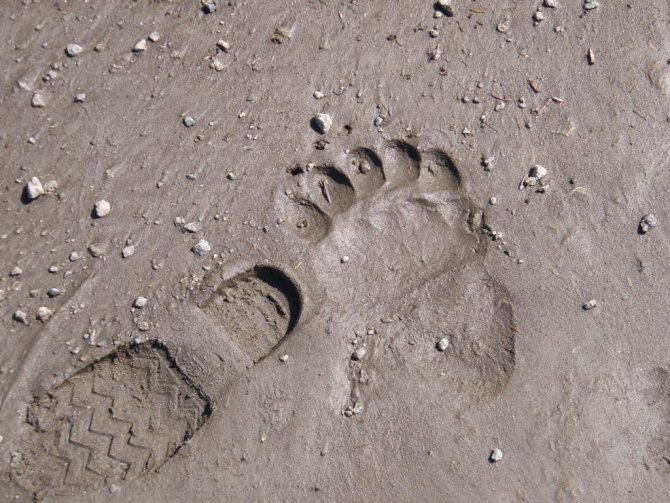
The photo shows a bear footprint next to the shoe print of an adult man (to analyze the scale of the paw). A detailed examination shows that below the fingers there is a peculiar tubercle - the metacarpal crumb; the wider it is, the older the animal. In a bear cub, the length of the crumb is 4-7 cm, in contrast to an adult male, in whom this figure reaches 25-35 cm.
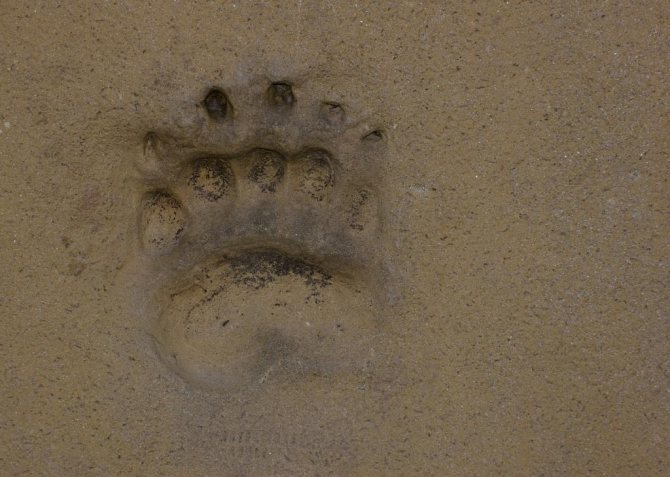
The footprint of a bear cub is significantly smaller than that of an adult predator.
What does a brown bear's hind paw print look like?
Such a bear track will always consist of an imprint of the animal's full sole. It is akin to the drawing that would result if a barefoot man with pronounced flat feet stood in the snow. But there is one serious difference. A person's toes become smaller from the inner edge to the outer edge. On the bear's paw everything is exactly the opposite. The toe on the inside of the foot is the smallest, and the rest get larger as they approach the outside of the foot. The claws on the hind legs are much shorter and more curved. But even here they leave a noticeable pattern near each finger.
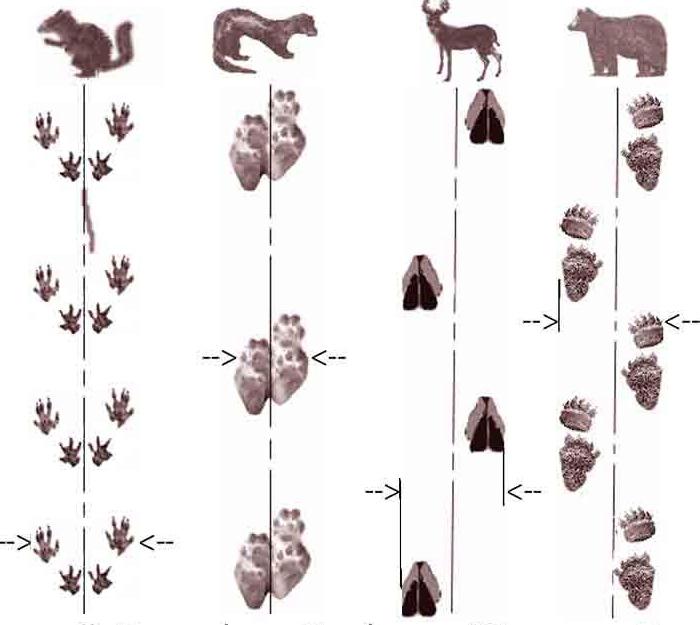
What does a bear's footprint look like?
Most often, the footprint can be found on the ground, not in the snow. This is due to the fact that in most cases the animal hibernates before snow falls. If traces of a bear are found during severe frosts, it means that the hunter is dealing with a connecting rod, which can be very dangerous. An animal emerging from a den in winter is hungry and angry, so a person should beware of an attack.
The tracks of the bear's front and hind paws are significantly different. On the front paws you can see five small pads, along which there is one wide callus. In addition, the claws on the front paws can reach 8-10 cm in length - they are 2 times longer than the claws on the hind paws. The print of the hind paws looks a bit like a human footprint. At the same time, the animal’s foot is wider than a human’s, and the bear’s footprint narrows towards the heel.
It also has five small toe pads on its hind legs and one long pad on its foot. If a bear stands still or walks slowly, a clear imprint of its hind paws remains on the soil. But if he runs fast, the heel remains suspended and leaves no imprint.
It is not so easy to find bear tracks on the ground, because this is a very cunning animal. He does everything possible to confuse possible pursuers. For example, before returning to the den, an animal can walk for a long time in one area in different directions, so that the hunter cannot understand which way the predator went. If a fallen tree is encountered on his way, he will leave the path and prefer to continue walking along the trunk so as not to leave marks on the ground.
Below is a photo of the bear's footprint.
Age of the bear based on its tracks
If we talk about the age of the animal, it can be determined by the size of the tracks. An example is the size of the metacarpal crumb of the front paw. Its approximate values are given in the table.
| Width in cm | Age of the individual |
| 5-6 | first year bear cub |
| 8-10 | second year bear |
| 11-18 | adult female bear |
| 14-17 | male |
| up to 20 | very large bear |
The length of the hind paw print of an adult bear can reach 31 cm. And it is no coincidence that the “club-toed” bear received its characteristic. He actually places his paws so that the toes point inward and the heel points outward.
Bear trail
In its habitat, the bear leaves a lot of different traces. This is facilitated by the large size and weight of the animal. On soft soil, in shallow snow, especially on forest roads, the deep imprints of the clawed paws of this predator are easy to notice. The bear is a plantigrade animal. On the front paw, in addition to five digital calluses or, as they are commonly called, pads, there is a large transverse, so-called palmar, callus, which leaves a deep and clear imprint on soft soil. The foot of the hind paw also has five toe pads and one oblong, plantar, callus located not across, but along the foot. The hind paw print resembles that of a bare human foot, but with a wide foot and narrow heel. When a bear walks slowly or stands, the entire foot leaves an imprint; if the animal walks quickly or runs, the heel remains suspended and does not leave a mark even on soft ground. The entire foot is imprinted on the snow at any gait. The bear's claws are very large, and on the front paws they are 1.5-2 times longer than on the hind paws, and reach 8-10 cm along the bend.
10/25/2015. The fresh footprint of the bear was clearly imprinted on the fallen snow. Photo by V.A. Bushmeneva
It’s not for nothing that the bear is called clubfoot: when it walks, its toes point inward and its heels point outward. Because of this gait, the imprint of the outermost finger, the “little finger,” is always deeper than the imprint of the inner, “big” finger. If the animal walked slowly, the prints of its front and hind paws are side by side; if it walked quickly, the hind paws overlap the prints of the front paws. From the tracks you can learn a lot of interesting things about the secretive life of a bear.
In winter, traces of a bear are rarely found, since the predator usually lies in its den before the snow falls. But if for some reason such a trace can be discovered, you can learn a lot of interesting things about the habits of the cautious animal. A hunter can follow a bear's trail for dozens of kilometers and study traces of its vital activity. If an animal is raised from a den in the middle of winter in winter, it turns into a tramp or, as people say, into a connecting rod. The connecting rod is a dangerous beast. He is hungry, irritated; in search of food, attracted by the smell of food, it approaches a person’s dwelling and makes attempts to catch an elk.
10/25/2015. The bear confuses its tracks before going into its den. Photo by V.A. Bushmeneva
Bears know well that the traces they leave reveal their location, and therefore they try to somehow hide them, resorting to various tricks, especially before going into a den. For example, they follow their tracks back and forth, or when an animal walks through the forest and encounters a fallen tree on the way, it will not fail to climb the trunk, walk along it to the end, and then jump to the ground. An interesting way for a bear to confuse its tracks is described by the famous hunter of this animal A.A. Shirinsky-Shakhmatov. According to his observations, before going into a den, a bear goes out onto the road, walks along it for a long time, and then, in order to confuse its possible pursuers, leaves it, backing away.
Source: ohotnadzorkirov.ru
What other marks do bears leave?
In addition to tracks on the ground and snow, you can also see other marks in the forest that these animals make.
The first thing to start with is tracks in feeding areas. For example, in the spring, when hungry bears emerge from their dens, they often empty anthills. Animals destroy their tops in order to get to insects and larvae. In autumn, bears are not averse to eating fruits from trees. There are always a lot of broken branches left in their feeding area.
The next noticeable signs of bear habitat are marks on tree trunks. It could be a scratch or a bite, abrasion or scuffing.
The abrasion is caused by friction against the bark when the bear stands on its hind legs. An animal can scrape a tree with its withers or the back of its head, its back or its chest. The bear makes a snack by standing on its hind legs and grabbing the bark with its teeth. The beast also does the bully thing while standing on its hind legs. Then he stretches his front paw up and pulls it down the trunk. As a result, narrow strips of cut bark appear at the bottom of the tree.
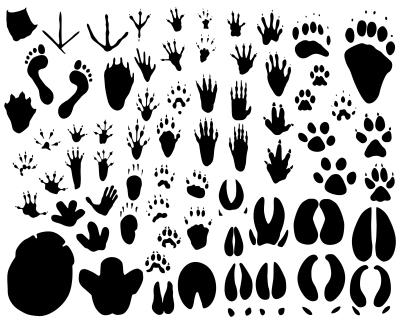
Bear cubs crawl through trees. At the same time, they clasp the trunk with their front paws. Four long, deep, oblique scratches remain on the bark. The fifth claw is not involved in this process. The scratches are directed from top to bottom and to the middle. For convenience, the cubs rest against the trunk with their hind paws. In this case, the claws dig deep into the bark.
Brown bear
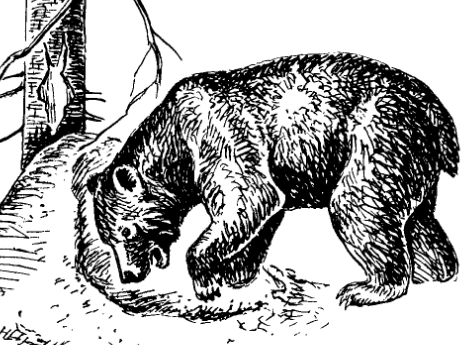
The brown bear is a heavy animal, so where it stays, its tracks are found quite easily. The body length of this animal is from 130–150 cm to 240–250 cm, weight from 56–80 kg to 250–300 kg, some reach 640 kg. Height at the withers is up to 1.3 m. The fur is long, thick, from light yellow-brown to brown-black. Bears leave clear paw prints on forest roads and on soft soil along the banks of rivers and other bodies of water. In spring we find them on the last snowdrifts, and in autumn on early fallen snow.
- Habitat biotope.
Forests with cutting areas, burnt areas, swamps, clearings. - What does it eat?
In spring - anthills, carrion, ungulates; in June–July - insects, aspen leaves, large grasses (umbelliferae: angelica, hogweed, angelica), bird eggs; late summer and autumn - berries (raspberries, lingonberries, cranberries, bird cherry, rowan), rodents, oats. - Ecology of the species.
Mainly crepuscular and nocturnal. Rutting in the summer. At the end of October–November it lies in a den until April–May. A sensitive dream - when disturbed, it comes out and turns into a dangerous, hungry and irritated connecting rod. In winter, 1–2 cubs (weight 500 g) are born in a den and feed on milk for up to 5 months. The she-bear leads the cubs for 2 years.
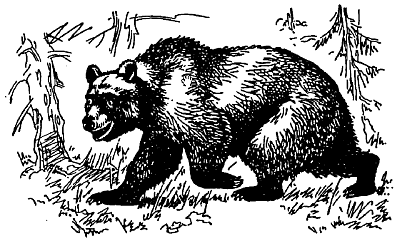
The brown bear is widespread in the forest belt of our country from the western borders to the coast of the Sea of Okhotsk and from the forest-tundra to the forest-steppe. It is also found in Transcaucasia, the Caucasus, the Pamirs and Tien Shan. The usual habitats of the brown bear are vast dark coniferous or mixed forests with swamps, burnt areas and berry fields.
It feeds mainly on plant foods: berries, rhizomes, angelica, unripe oats, acorns, nuts, and wild fruits. Its diet includes ants, beetles and their larvae, rodents, frogs, lizards, birds and their eggs; greedily eats carrion; the hungry eats the buds of trees; In early spring it attacks ungulates. In Kamchatka, fish is of great importance in the bear's diet, and on the sea coast - sea emissions.
The bear lies in a den in late autumn, and emerges from it in the middle zone in April, in the north - in May. “Connecting rods” that have not laid down for the winter can attack people and domestic animals. The female bear mates once every two years; rut - in June–July; cubs appear in the den in winter. Bears molt once a year - in the summer.
Brown bear front paw print
The prints of the front paws of this predator are easy to distinguish from the prints of the hind legs. The front paw leaves noticeable imprints of the crumbs of all 5 fingers, behind which a wide kidney-shaped imprint of the metacarpal crumb is visible, narrower on the inside and wider on the outer edge. Noteworthy are the deep grooves in front of the fingerprints, left by long, slightly curved claws.
The bear is plantigrade, and its back paw leaves an imprint of the entire sole. The five-toed footprint of the hind paw resembles the footprint of a bare foot of a person suffering from flat feet. However, if a person’s toes become smaller from the big to the little toe, then for a bear it’s the other way around: the smallest first (inner) toe, and the rest enlarge towards the outer edge of the foot. At least I noted this on most of the bear footprints I encountered. We also see claw prints on the traces of the bear’s hind limbs. But on the hind legs the claws are noticeably shorter and more curved.
Brown bear hind paw print
To imagine the size of the animal from the tracks it left, it is enough to measure the width of the metacarpal crumb on the imprint of the front paw. For cubs of the year, this width ranges from 5 to 6.5 cm, for bears born last year - from 8 to 10, for mature female bears - from 11 to 18 (for female bears in central Russia - no wider than 14 cm), in seasoned animals - from 14 to 17, in especially large individuals - up to 20 cm.
At the same age, males are usually larger than females. The length of the trail of the hind leg of the largest males can reach 31 cm. When walking, the bear noticeably clubbing, placing its paw inward with its toe and “heel” outward. At a slow pace, the prints of the front and hind paws are located next to each other or the hind paw is imprinted on top of the front print - the so-called covered track is obtained. Often, when moving slowly, an animal leaves a trail with half-covered tracks, and then we see that the prints of the hind paws overlap to varying degrees from behind the prints of the front ones. When moving quickly, the prints of the hind paws appear in front of the prints of the front ones - this is an overlapped track. Consequently, by the location of the prints, one can determine the speed of the animal’s movement, whether it was walking at a slow pace or in a hurry.
Traces of bears moving at a calm pace: a - male; b - females; c - teddy bear
The large size of bear paws makes it possible to notice all possible individual features of the tracks of each animal: the size of the paws themselves, the shape of the fingers, the length of the claws, the outlines of the soles and metacarpals. Any defects in the fingers or claws, if any, will not escape an attentive eye. All this allows an experienced tracker to recognize by the tracks of many bears living in a given area.
It is believed that only bear cubs climb trees. Climbing up a tree, the animal grabs the tree from the side with its front paws to hold on. There remain 4 deep oblique scratches up to 11 cm long, directed from top to bottom and inward. The animal rearranges its hind legs one by one, digging its claws deep into the bark. It is noteworthy that only 4 paw claws scratch the bark - the inner, shortest claw does not participate in the work.
In bear habitats, you can find various marks left by this animal on the trunks of mostly coniferous trees. These are abrasions, scratches, scuffs and bites. With various explanations for the appearance of such marks, most researchers believe that in this way the animal marks its individual area. This opinion is supported by the fact that fresh bullies and snacks appear before and during the rut. The predator makes snacks with its teeth at the height of its height, standing on its hind legs. Abrasions occur when marking a tree trunk, when the animal rubs its chest, back, withers and nape against the bark. At the same time, he also stands on his hind legs. The bullying starts from above, at the height of an outstretched paw of a bear standing on its hind legs. It stretches out its front paw and uses its claws to tear at the bark from top to bottom. In these cases, narrow strips of stripped bark appear at the foot of the trunk.
The bear leaves many traces of its activity when feeding. In the spring, after getting up from the den, he often visits anthills. When catching insects, it severely damages its upper part. In the autumn, feasting on the fruits of pears, apples, cherry plums, rowan berries, and other berries and fruits, the bear bends down and breaks many fruitful branches. He eats walnuts, hazel fruits or pine nuts along with the shell.
Traces of other animals in the snow
- Wolf. Its tracks can be difficult to distinguish from those of a dog. The main feature is how the outer fingers are positioned. In dog tracks they move further away from the heel. And they also end at a different distance. If this is the footprint of a wolf, then the ends of the prints of the side fingers slightly reach the beginning of those in the middle. In a dog, their endings will be on almost half of the inner fingers.
- Fox. Externally, its tracks are very similar to those of a dog. But they have a peculiarity: they are stretched into a thin chain.
- Boar. Their hooves are small and cloven. If they are left on the snow, the marks will be deep. Because this beast is heavy, and the snow cannot support it.
- Elk. Similar to wild boar, but significantly larger. And the elk’s stride is noticeably wider.
- Mouse. She leaves a chain of two parallel stripes of small traces.

